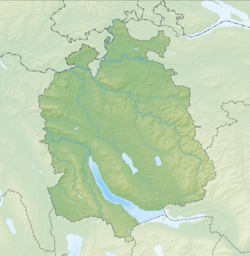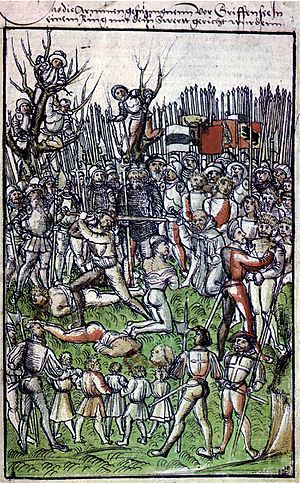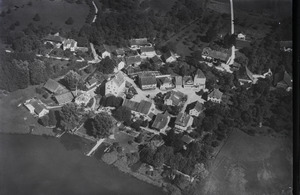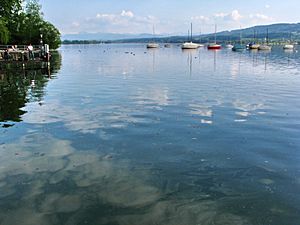Greifensee, Zürich facts for kids
Quick facts for kids
Greifensee
|
||
|---|---|---|
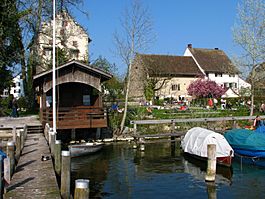 |
||
|
||
| Country | Switzerland | |
| Canton | Zürich | |
| District | Uster | |
| Area | ||
| • Total | 2.27 km2 (0.88 sq mi) | |
| Elevation | 439 m (1,440 ft) | |
| Population
(Dec 2020 )
|
||
| • Total | 5,307 | |
| • Density | 2,338/km2 (6,055/sq mi) | |
| Postal code |
8606
|
|
| Surrounded by | Fällanden, Maur, Schwerzenbach, Uster, Volketswil | |
Greifensee is a small town, also called a municipality, in the Canton of Zurich in Switzerland. It is located in the Uster district. Greifensee is known for its beautiful lake and its old castle.
Contents
History of Greifensee
Early Settlements
People have lived in the Greifensee area for a very long time, since about 4000 B.C.. In 1975, divers found an ancient village made of stilt houses on the northern shore of Lake Greifen. This village was called Böschen.
They found old ceramic pots and bowls, some with fancy decorations. Scientists later explored the site and found the remains of 24 huts. The wood from these huts was so well preserved that they could tell the village was built in 1051 B.C.
They also found weaving tools made of clay, bronze tools, needles, and fishing hooks. Even charred wild apples and grains were found! Sadly, the settlement was destroyed by a fire ten years after it was built and was never rebuilt.
Later, other ancient items were found in the Zurich area. These included heavy bronze bracelets, glass, and bronze brooches. Some flint blades found might have come from the Mediterranean or France. Signs of the Roman period were found in nearby towns like Riedikon and Pfäffikon.
Greifensee in the Middle Ages
Around the late 1100s, a tower house was likely built where Greifensee Castle now stands. This was probably a settlement started by the Counts of Rapperswil.
Greifensee was an important area called a bailiwick (Landvogtei). It was ruled by different noble families, including the Counts of Rapperswil and Toggenburg, before becoming part of Zurich from 1300 to 1798.
In 1300, a noblewoman named Elisabeth von Rapperswil gave Greifensee to Hermann II of Landenberg. His son, Hermann IV, made the small town stronger by building up Greifensee Castle and its city walls. He also helped build the Gallus Chapel around 1330–1340.
In 1369, the area of Greifensee was sold to Count Friedrich Donat Diethelm of Toggenburg. Later, in 1402, Friedrich VII sold it to the city of Zürich. From 1419, Greifensee became the first country bailiwick ruled directly by the city of Zurich.
A sad event happened in May 1444 during the Old Zurich War. The Old Swiss Confederacy attacked Greifensee. About 70 defenders, mostly local people and some soldiers, protected the town. After four weeks, on May 27, the town was captured. Most of the captured defenders were sadly put to death the next day, including their leader, Wildhans von Breitenlandenberg. Even during wartime, this mass execution was seen as a very cruel act. On May 29, Greifensee Castle and its city walls were destroyed.
Later History
In 1520, Zurich decided to rebuild the castle ruins. It became the home for Zurich’s local governors, called Landvögte. Famous governors included Heinrich Biberli and Salomon Landolt.
The town's coat of arms, which shows a red griffin (a mythical creature), dates back to the 1400s. It became the official town symbol in 1930.
Geography
Greifensee covers an area of about 2.3 square kilometers (0.89 square miles). A good portion of this land, about 37.3%, is used for farming. About 11.6% is covered by forests.
Most of the town's land, about 44.6%, has buildings or roads on it. The rest, 6.4%, is non-productive land like rivers or mountains.
Greifensee is located right on Lake Greifen, about 12 kilometers (7.5 miles) east of Zurich. The town has a charming historic part with an old castle and a very special church called the Gallus Chapel. This church is shaped like a triangle so it could fit perfectly within the old city walls!
People of Greifensee (Demographics)
Greifensee has a population of about 5,700 people. As of 2007, about 15.2% of the people living there were from other countries. The population has slightly decreased over the last ten years.
Most people in Greifensee (88.3%) speak German. French is the second most common language (1.7%), followed by Italian (1.5%).
In 2007, the most popular political party in local elections was the SVP. Other popular parties included the SPS and the FDP.
About 25.3% of the population are children and teenagers (0–19 years old). Adults (20–64 years old) make up 65% of the population, and seniors (over 64 years old) make up 9.7%. Most people in Greifensee are well-educated. About 85.5% of adults have finished high school or gone on to higher education like university. There are 2198 households in Greifensee.
As of 2008, there were 1464 Catholics and 2085 Protestants in Greifensee. In the 2000 census, about 48.1% of the population were Protestant, and 31.3% were Catholic. About 12.7% of the people said they were atheist or agnostic.
The population of Greifensee over time is shown in this table:
| year | population |
|---|---|
| 1634 | 133 |
| 1799 | 278 |
| 1836 | 406 |
| 1850 | 396 |
| 1900 | 289 |
| 1950 | 279 |
| 1960 | 421 |
| 1970 | 2,674 |
| 1980 | 5,423 |
| 2000 | 5,242 |
Cultural Heritage
The ancient site of Greifensee–Storen–Wildsberg, located on the lakeshore, is part of a very important UNESCO World Heritage Site. This site includes 56 different prehistoric pile dwellings (stilt house villages) around the Alps. The Greifensee settlement is also listed as a "Class object" in the Swiss list of important cultural properties. Because the lake has grown over time, the original wooden piles of the ancient village are now about 4 to 7 meters (13 to 23 feet) under the water.
Industry and Economy
Mettler Toledo, a big company, has one of its main offices in Greifensee. It is also the largest employer in the town.
Greifensee has a low unemployment rate of 1.92%. In 2005, a small number of people (21) worked in farming. More people (557) worked in manufacturing and construction. The largest number of people (548) worked in the service industry, which includes things like shops, offices, and tourism.
Transport
The Nänikon-Greifensee railway station is a stop on the Zurich S-Bahn train lines S9 and S14. You can get to Zürich Hauptbahnhof (Zurich Main Station) in about 16 minutes on the S9 train.
Notable People
- Johann Jakob Bodmer (1698 in Greifensee – 1783) – A Swiss writer, academic, and poet.
- Sándor Végh (1912–1997) – A Hungarian and later French violinist and conductor who lived in Greifensee from 1971.
See also
 In Spanish: Greifensee para niños
In Spanish: Greifensee para niños




